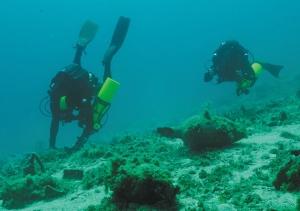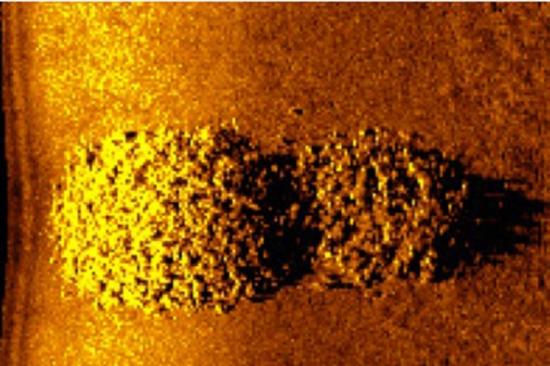PART.2
Diving deeper
Wachsmann says that he isn't surprised by what Foley saw. From 2007 to 2009, he led the Danaos project, using sonar-equipped ROVs to survey hundreds of square kilometres of sea floor on a suspected ancient trading route between Crete and Egypt. In three seasons, he didn't find a single ancient wreck from any period, and only a scattering of artefacts.

Divers investigate a first-century-AD wreck near the Greek island of Dia. B. FOLEY
Wachsmann found that sedimentation was a problem even far from shore — up to a metre per millennium in some areas. This means that although some Greek and Roman remains might still be visible, a Minoan ship would be buried under 3 or 4 metres of sand. And even at 500–600 metres depth, he saw clear evidence of trawling. “It was almost like somebody had swept the sea in front of me,” he says. On the basis of his experiences, Wachsmann now believes that the chance of finding a Minoan equivalent of Ulu Burun “approaches zero”.
The effect of bottom trawling is “devastating” for archaeologists, agrees Robert Ballard, an oceanographer based at the University of Rhode Island in Narragansett, who has pioneered deep-sea exploration and discovered the wreck of the Titanic in 1985. “Most of the Aegean has been destroyed,” he says.
Ballard has spent years searching for ancient wrecks and says that he has learned the importance of finding areas beyond the reach of fishermen — below about 600 metres, say, or close to undersea cables, which trawlers avoid. He has also opened up his search area. Historians once assumed that the number of wrecks in the deep sea was negligible because ancient ships must have hugged the coastlines, but in the 1990s Ballard found eight ancient wrecks far from shore between the islands of Sicily and Sardinia2 (Foley was Ballard's graduate student at the time). “The ancient mariner was not afraid of going out to sea,” says Ballard.
Since 2008, Ballard has been exploring the eastern Mediterranean, the Aegean and the Black Sea with a suite of ROVs. Although he is finding large numbers of ancient wrecks, he hasn't yet uncovered anything from the Bronze Age. But, like Foley, he believes Minoan ships are waiting to be discovered. The key to finding the oldest wrecks, he says, is locating “relic surfaces” that have escaped being buried by sediment, which flows downhill and covers the deep sea floor3. “What you want is a shipwreck that came down on a mountain,” he says, because sediment can't accumulate on a steep slope.
Last year, Ballard investigated the Eratosthenes seamount, a 700-metre-deep tabletop south of Cyprus, and says it does indeed seem to represent a relic surface. He is now applying for permits to return to Eratosthenes to search for shipwrecks next year. Another area he would like to investigate is the submerged Anaximander mountains south of Turkey. It would be difficult to distinguish a wreck site from such rocky terrain using sonar, so he plans to use video cameras to conduct a painstaking visual search over smaller areas. “It's very hard hunting,” he says.

In a 2010 survey, the sonar technique identified several underwater wrecks including a 19-metre-long Byzantine one, shown in this sonar image. The team plans to return next year to explore deeper waters for more ancient wrecks. NORTHERN SPORADES SURVEY 2010/EUA/WHOI
Foley is also now looking to the deep sea, but has a different strategy. Instead of targeting particular sweet spots, he wants to cover as large an area as possible. He has raised more than US$1 million towards the $1.8 million that he needs to return to the Mediterranean next year, this time with two of Gudgeon's more powerful cousins, REMUS 6000s owned by the Waitt Institute in La Jolla, California.
To maximize the chances of finding ancient wrecks, the team will hunt on open, flat areas in the lowest reaches of the sea, up to 6,000 metres deep. Foley estimates that the two REMUS vehicles can cover up to 5,000 square kilometres in one month, equivalent to 1% of the entire Aegean Sea. The recent field trial around Dia encouraged Foley because it should be easier for the sonar surveys to pick out vases than it was to find plastic water bottles, which are poor sonar reflectors, he says.
Both Ballard and Foley are ultimately hoping to use their surveys to catalogue large numbers of wrecks of all ages across great swathes of the Mediterranean and the Black Sea. Through a combination of sonar and high-resolution digital photography, they can compile detailed three-dimensional maps of a wreck site and answer questions about the date, origin and cargo of a ship without bringing up a single artefact.
Foley estimates that hundreds of thousands of ships must have sunk in ancient times — including thousands in the Bronze Age alone — and that a significant proportion of those are still sitting at the bottom of the deep sea. If he's right, then perhaps researchers will eventually have not just one Minoan ship, but hundreds. With enough wrecks, says Foley, “it ought to allow us to draw new conclusions about this absolutely formative period in human experience.”
That could shift marine archaeologists into an era in which they can use statistical data gathered from hundreds or thousands of wrecks to build up a bigger picture of trade routes, migration and warfare throughout history. “We'd rather find 500 ships than excavate one,” says Ballard.
Such a dream seems a long way off as Foley's team packs up its gear at the end of its campaign. Packard and Dennett carefully lower Gudgeon into a crate for its long trip back to Woods Hole, while Foley eyes one of the artefacts he retrieved from Dia's waters — a bulbous Byzantine amphora covered in deposits left by worms.
It's not the find Foley hoped for, but he is undaunted — this is just the beginning of what he knows could be a long search. “I'd like to be doing this every year for the next 20 or 30 years,” he says. “Until I'm too old to go to sea.”
Nature 481, 426–428 (26 January 2012) doi:10.1038/481426a
References
- Pulak, C. in Beyond Babylon: Art, Trade, and Diplomacy in the Second Millennium B.C. (eds Aruz, J., Benzel, K. & Evans, J. M.) 289–310 (Yale Univ. Press, 2008).
- Ballard, R. D. et al. Deep Sea Res. I 47, 1591–1620 (2000).
- Canals, M. et al. Rapp. Comm. Int. Mer Médit. 38, 47 (2007).